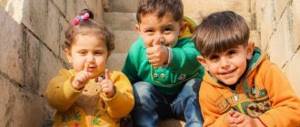Every year on November 16, people around the world celebrate the International Day for Tolerance, or Tolerance Day for short. This day was approved by UNESCO in 1995, but every year it becomes increasingly important, since the development of tolerance is increasingly recognized as one of the most important tasks of our time. It is enough to open the latest news in a newspaper or the Internet to see what tragedies a hostile attitude towards a foreign culture, religion, or language leads to. There is no doubt that if humanity learned to be more tolerant, we would live in a better world than we do today. Therefore, it is so important to talk about this with children, because tolerance depends primarily on culture and upbringing, it does not appear suddenly and cannot simply be established by law.
What is tolerance?
We can simply say that tolerance is tolerating others.
But that’s where the simplicity ends, because we shouldn’t be tolerant of the fact that the strong offend the weak or the neighbor litters the entrance. It is important to understand this issue yourself in order to be able to teach this to your child. So, despite the apparent simplicity of the topic, there are two pitfalls in it that can easily lead to confusion. We have outlined the first: tolerance does not mean tolerance for crime, hooliganism, rudeness and other not the best manifestations of man. One must be tolerant of the fact that “people by nature differ in appearance, position, speech, behavior and values.” These are the words from the UNESCO Declaration of Principles on Tolerance. As we see, they talk about differences in people and this is precisely what the correct understanding of tolerance lies in. We must recognize that all people are different, but at the same time equal. This means that if we see that a representative of another nationality or religion commits a crime, then we should condemn him for a bad act, and not because he himself is different from us. We need to learn to distinguish one from the other and teach this to children.
Another pitfall lies in the word “tolerance” itself. Because of it, you might think that we are being asked to learn to tolerate something, to turn a blind eye to other people we don’t like. In fact, the principle of tolerance teaches something completely different: first of all, we should learn not to feel hostility towards others for being different, and not to restrain the manifestations of this hostility in ourselves. The words “tolerant” and “tolerant” should not be confused. Learning to be tolerant means letting go of the need to endure.
Photos of crafts for adults
Read here - Bird craft: a simple and clear master class for making beautiful birds in the form of toys and decorations (105 photos)
Did you like the article?
0
How to tell children about tolerance?
We have seen that even for an adult, the topic of tolerance may not be the easiest. Moreover, it is not so easy to explain it to children, and yet it can and should be done, and there are many ways to do this. Here are some of them:
- Draw your child’s attention to examples of tolerance and its absence. No need to invent anything! Most modern full-length cartoons or films for children touch on the topic of tolerance in one way or another. If your child loves cartoons, great. But after he has watched the next one (for example, with you in the cinema), draw his attention to examples of tolerance or intolerance in history. Explain how important this is and that in life you need to not only be tolerant, but also not be afraid to show it to others. The child strives to imitate the role models of the heroes of the story. It is enough to emphasize to him examples of tolerance in these models, and he will want to repeat them in life.
- Teach your child to notice the diversity of the world and people. In today's world of global culture, children admire singers, actors and athletes of various nationalities, cultures, and skin colors. Draw their attention to this, tell different interesting stories from their biography or about the country where they come from. A child must get used to the idea that he lives in a very rich and diverse world, and if he wants to be like his idols, he needs to learn to love the world just like that. Situations are useful where the child himself can feel different and understand how important it is when you are treated as an equal. Traveling abroad is especially useful for this, where you can get acquainted with other cultures and understand for yourself what openness and hospitality mean. If such events are not planned in the near future, then it is worth paying attention to festivals of national cultures, which are held regularly and most have a children's program. It is important not just to go there with your child, but to tell him how great it is when different cultures coexist side by side and how interesting it is to immerse yourself in one or another of them. Finally, even a visit to a good restaurant serving national cuisine is suitable for getting to know a foreign culture. Trying an unusual but tasty dish is a wonderful lesson in living in a tolerant world.
- Help your child learn to see the familiar in what at first seems foreign. To develop tolerance, it is important to understand that although people may differ from us in some ways, we all have much more in common - we have mom and dad, home, friends and favorite games. For younger children, this can be explained using animals as an example. For them, in games or small skits that they learn with a teacher, it is common for them to be bunnies, foxes, bears - ordinary heroes of fairy tales. Arrange for children to be a snake, a bug, a spider, a toad, a bat, and so on in a new game or skit. At the same time, the plot of the game or skit should not be very different from the usual ones. This will help children understand that although these animals may cause hostility or even fear in everyday life, they are actually no worse than others, they have ordinary affairs and worries, and it is no one’s fault that they were born a snake and not a bear.
These are just three examples, but of course there could be many more. The most important thing is to understand the basic principles of tolerance yourself and not forget about them when introducing your child to the world. Needless to say, the main example for a child is his parents. You need to teach by example and then the lessons will be learned very easily.
Planning Tolerance Week in kindergarten
The implementation of Tolerance Week is discussed and approved by pedagogical councils, usually in 2 stages:
- Voicing current tasks for promoting tolerance in kindergarten, discussing the start date of Tolerance Week, identifying possible events.
- Submission of an action plan (from educators, social pedagogue and psychologist, music and physical education directors) and approval of the Tolerance Week program.
Traditionally, Tolerance Week is held in kindergartens and schools in November - before the International Day of Tolerance (November 16).
Tolerance Week in kindergarten involves unusual activities and events:
- classes in a non-traditional form (game, integrated), including using ICT (information and computer technologies),
- musical holiday: children prepare numbers with national dances and songs together with a music director and a choreography teacher,
- short-term projects or the final event for a long-term project,
- physical education leisure: a day of folk games and outdoor activities,
- competition of drawings, crafts, motivational posters,
- master classes for parents.
As part of the Tolerance Week, child-parent events are held at the preschool educational institution
Table: example of planning for Tolerance Week
| date | Event | Participants | Responsible, organizers |
| 12.10 | Making posters and wall newspapers on the theme “Friendship of Peoples”, placing materials in the hall and recreation areas of preschool educational institutions. | Preschoolers of all ages together with parents and educators. | Teachers, senior teacher. |
| Integrated lesson “There are very different children on this huge planet.” | Pupils of the first and second junior groups. | Teachers and music director. | |
| Consultation for parents “Cultivating tolerance in modern society.” | Parents of middle, senior and preparatory groups. | Social educator, psychologist. | |
| 13.10 | Joint activity with parents “Educating tolerance through fairy tales.” | Parents and children of middle and senior groups. | Educators. |
| Physical education leisure “Moveable folk games”. | Younger preschoolers. | Physical education director. | |
| 14.10 | View a presentation and cartoon on the topic “What is tolerance?” | Pupils of the senior and preparatory groups. | Senior teacher, psychologist. |
| Musical leisure “Dances of the peoples of the world” (with master class). | Parents and pupils of junior and middle groups. | Educator, choreography teacher. | |
| 15.10 | Physical education “Sport unites countries and peoples.” | Pupils of middle, senior, preparatory groups. | Physical education director. |
| Exhibition-competition of crafts and drawings “The Magical Land of Tolerance”. | All preschool pupils (younger ones - together with parents and group work). | Teachers, head of the art group. | |
| 16.10 | Festive concert dedicated to Tolerance Day. | All preschool pupils. | Musical director, senior teacher, director of the theater studio. |
There may be several festive events (concerts) planned - for younger, middle and older pupils. This organization gives each group the opportunity to express themselves creatively and invite parents as spectators.
Video: celebration of Tolerance Day in the senior group
The most interesting and exciting thing about concerts and celebrations during Tolerance Week is the opportunity to try on the national costumes of residents of distant countries. It is recommended to involve parents in the production of attributes and elements of national clothing.






